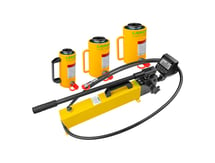Pull-out test
A pull-out test is a method used to assess the strength of an anchor or fixing embedded in a material, typically concrete, by measuring the force required to pull it out. This test is crucial for ensuring the reliability and safety of structures and components where fixings are used.
7/1/20251 min read


Here's a more detailed explanation:
What it measures:
Pull-out tests measure the tensile capacity of an anchor or fixing by determining the force needed to detach it from the surrounding material.
The test provides insights into the bond strength between the anchor and the material, or the mechanical interlock of the fixing.
How it works:
A specialized rig is attached to the anchor or fixing, and a tensile force is applied to pull it out.
The force is gradually increased until the anchor breaks free or reaches a predetermined level.
The force required to pull out the anchor is measured, providing a quantifiable measure of its strength.
Importance:
Pull-out tests are essential in construction and civil engineering to verify the integrity of anchors and fixings.
They help ensure that structures can withstand the loads they are designed to bear.
The tests are particularly important for safety-critical applications, where failures can have severe consequences.
Types of pull-out tests:
Destructive pull-out test:
The anchor is pulled to failure, providing a measure of its ultimate strength.
Non-destructive pull-out test:
The anchor is pulled to a specified load level, which is a fraction of its expected strength, to assess its performance without causing damage.


